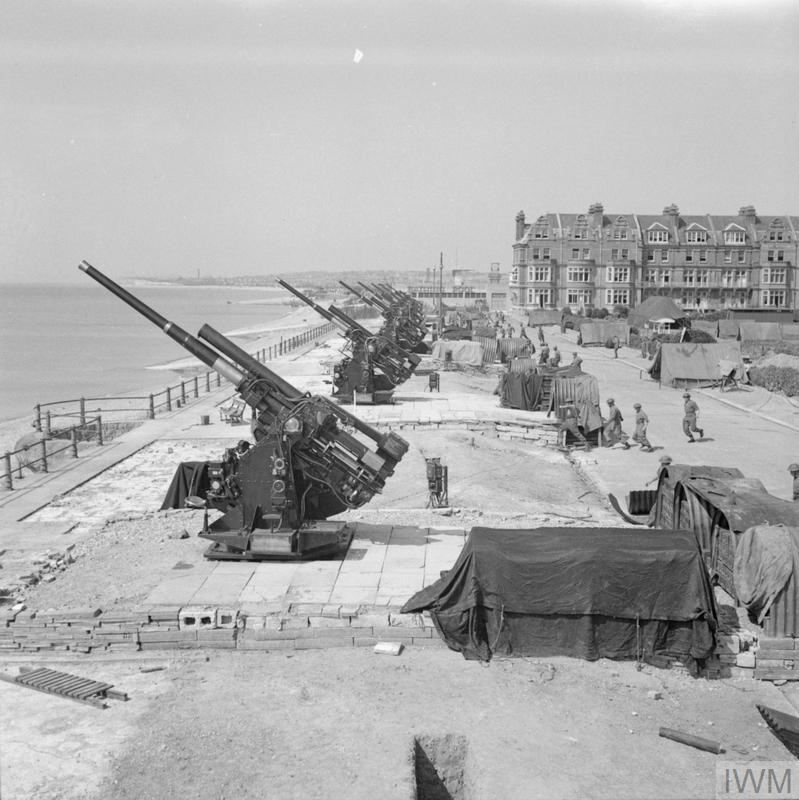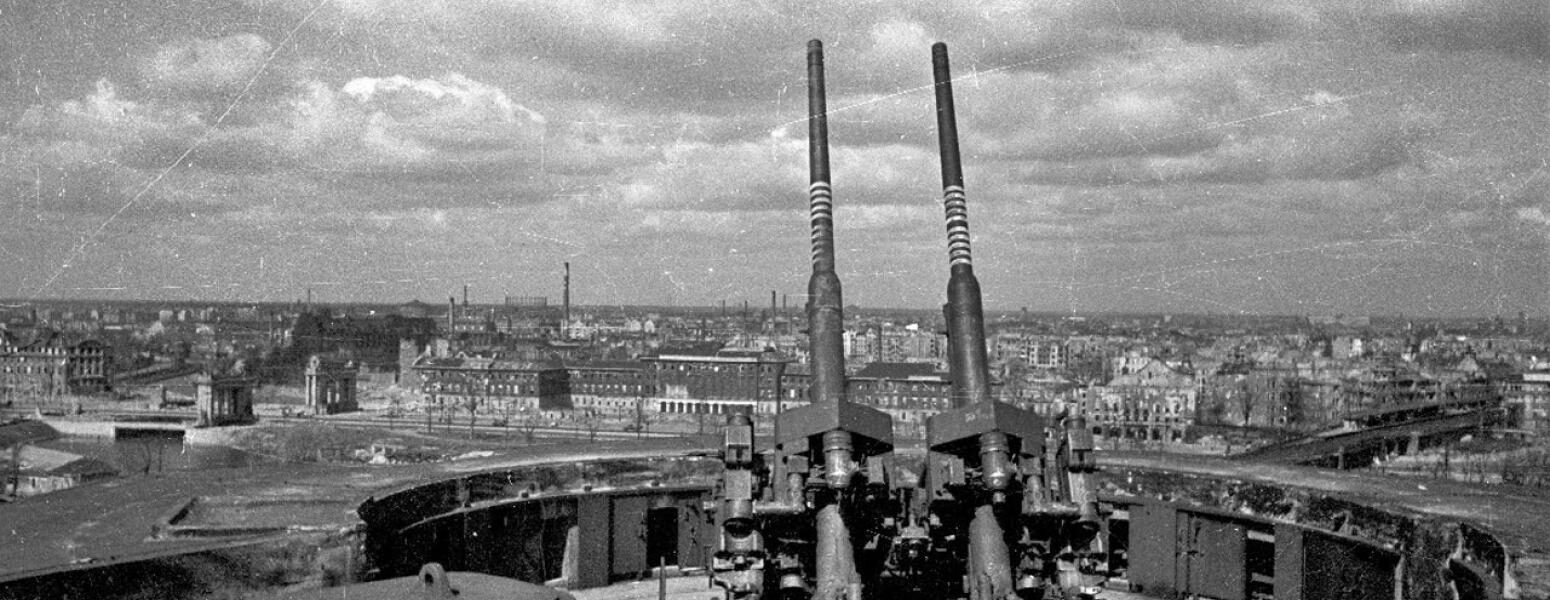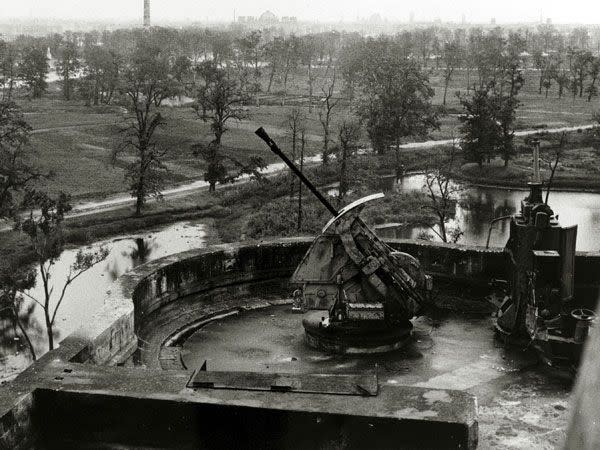- Homepage
- Uncategorized
- View of the powerful 12.8 cm double anti-aircraft gun from the large Zoo bunker in Berlin – the Charlottenburg Gate in the front left! _de
View of the powerful 12.8 cm double anti-aircraft gun from the large Zoo bunker in Berlin – the Charlottenburg Gate in the front left! _de

Berlin, mid-1940s: On the roof of the massive Zoo Bunker stands one of the most impressive anti-aircraft installations of World War II—the 12.8 cm double-barreled anti-aircraft gun. This photo, taken by British photographer Cecil FS Newman, shows the view to the northwest, with the Charlottenburg Gate clearly visible in the foreground. This image is not only a technical document of the era, but also a silent witness to a city in a state of emergency.

The Zoo Bunker, officially called the Tiergarten Flak Tower, was built between 1940 and 1941 in response to the increasingly intensive Allied air raids on the German Reich. It was part of a system of three flak towers in Berlin (Tiergarten, Friedrichshain, and Humboldthain) that played a central role in the air defense of the Reich capital. The 12.8 cm anti-aircraft guns installed here were among the largest and most powerful of their kind in the world. Each twin flak tower could fire up to 14 rounds per minute and engage targets at an altitude of over 14 kilometers.
The photograph conveys a mixture of technical fascination and historical gravity. As the massive tubes of the anti-aircraft guns reach into the sky, one senses the purpose of these weapons: to defend the skies above Berlin—a task that became increasingly hopeless given the overwhelming superiority of the Allied bomber forces. From 1943 onward, the air raids intensified; the city was transformed into an inferno of firestorms night after night.

The surroundings of the photo are also remarkable. In the left foreground, you can see the Charlottenburg Gate, a neoclassical building that once marked the western entrance to Berlin’s city center. These peaceful architectural elements contrast sharply with the brutal function of the flak tower. The photo recalls how closely war and everyday life coexisted at that time: While people waited in shelters below the bunker, the guns thundered above against the approaching bombers.
The Zoo Bunker itself was not only a military position, but also a refuge for tens of thousands of Berliners. The massive walls provided protection for civilians, hospitals, and even art treasures, which were secured from bombing raids. Eyewitnesses recount depressing scenes: children playing among pipes and ammunition crates while sirens wailed outside; elderly people persevering in the stuffy air-raid shelters, feeling the roar of the guns above them.

When the Red Army marched into Berlin in April 1945, the Zoo Bunker became the scene of heavy fighting. The 12.8 cm anti-aircraft guns eventually began firing their guns not only at aircraft, but also at tanks and infantry on the ground. The bunker was long considered impregnable and only surrendered after intense fighting. For many Berliners, it remained a symbol of doom—a memorial to the madness of war.
Today, the Zoo Bunker no longer exists. After the war, the Allies blew up most of Berlin’s flak towers, as they were neither suitable for civilian use nor suitable for urban development. What remains are historical photographs like this one, which offer us a rare glimpse into the reality of those years. Newman’s photo not only documents military technology, but also tells of an entire era—of fear, destruction, and also a city’s will to survive.
When we look at this picture today, we see more than just steel and concrete. We see the traces of a time when Berlin was one of the most contested cities in the world. We realize how closely intertwined history and the present are: The Charlottenburg Gate still stands today, but the flak tower has disappeared—a silent reminder of how much the city has changed.
Related Posts

The Panzerkampfwagen VI Tiger I – Heavy Tank _de
If one compares the small number of Panzerkampfwagen VI Ausf. E (Sd Kfz 181) Tigers (only 1,346) with the total of over 120,000 T-34s and Shermans, the psychological…

1,700 rounds per minute: The MG34 was Hitler’s super weapon _de
The design of the MG 34 originated in Germany during the interwar period. Until World War II, machine guns were typically water-cooled—and accordingly heavy and immobile. Efforts to…

Tiger! Panzer VI – Combat and Operational Assessment – 252 Hits in Combat – World War II
Currently, “real life” is taking up most of my free time, so I’ll only be publishing a few short articles over the next few weeks to keep you all awake…

The T-34 Tank: The History of the Soviet Union’s Rugged Armored Vehicle
By Phil Zimmer December 1941 was a bleak month and the end of a bleak year for the Soviets. The Germans continued to push toward Moscow,…

Armed and armored Willys MB Jeeps
In the US and Great Britain, intensive work was carried out on the development of special airborne vehicles that could land behind enemy lines. Willys MB Jeeps supported the infantry in…






